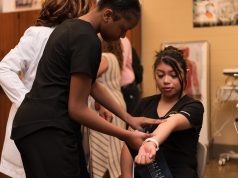
By Erica Wright
The Birmingham Times
The Women’s Fund of Greater Birmingham this week released its inaugural report, “2020 Status of Women in Alabama”, the first of its kind delving into statewide and county-by-county well-being indicators for women.
The report, based on data compilation by the Institute for Women’s Policy and Research (IWPR), is an important benchmark on the issues impacting women the most including geographic location, race, ethnicity and age and offers insight to the realities women face.
“In the women’s funding world, we often say that gender equity is not issue, it’s every issue,” said Melanie Bridgeforth, President and CEO of The Women’s Fund. “Our work is just that. We are funders for gender equity. We envision a society where power and possibility are not limited by gender and as our state and region’s only public women’s foundation our mission and has to be anchored in the power of targeted philanthropy.
“We know that while philanthropy is necessary, it’s not sufficient in adequately addressing and dismantling barriers and redesigning systems that work for and not against women… it is through our research and advocacy that truly gives our mission lift and rise,” she said.
Women are 52 percent of the population in the state of Alabama, but they are 100 percent necessary for families to thrive, said Bridgeforth.
“I always say and have said for quite some time that what gets measured is what gets changed. You cannot change what you don’t know and you cannot change what you can’t see,” she said. “We felt strongly that by producing responsible and credible data, that illuminates gaps and benchmarks progress, we can also make a difference and improve the status of women in Alabama simply by shining a light.”
The report focuses on four essential areas that impact the quality of life: work, earnings and family; poverty and opportunity; health and well-being; and political representation and leadership, as well as early indicators about the effects of COVID-19.
“Over the years, we’ve done numerous national reports but we’ve also done deep dives on states, but more recently we have been really partnering with the Women’s Fund here to do a deep dive at the county level,” said Elyse Shaw, Study Director at the IWPR. “We’ve released a series of reports for different states and we’re so happy to add Alabama to that list of data analysis in addition to our national reports… we just keep going on what is going on for women of the United States.”
In developing the report, it shines a light on the disparities that women face in the United States and relies heavily on data from government surveys and stats, Shaw said.
According to Shaw, key findings of the report include:
- Women with children who wish to enter the workforce face steep childcare costs: the annual cost for an infant (under 12 months old) in Alabama is $5,858, nearly 17 percent of women’s median annual earnings.
- The gender wage gap in Alabama is wider than in most states and the national average. Women in Alabama earn only 73 cents for every dollar a man earns, compared to 82 cents for U.S. women overall.
- Women make up 15.7 percent of the Alabama Legislature (22 out of 140 members). On average, women make up 29.2 percent of a state’s legislature.
- Women in Alabama are more likely than men to have filed for unemployment during the COVID-19 pandemic, accounting for 57.3 percent of total claims.
- Approximately 37.5 percent of Alabama women have experienced sexual assault, physical violence and/or stalking by an intimate partner.
Based on the gender wage gap findings, Shaw predicts that women in Alabama will not close the gap until the year 2089.
“If progress remains the same, no policy interjections, nothing happens, we predict that women in Alabama will reach pay equity in the year 2089, that is a really long time and that is an additional 29 years than women in the U.S. overall,” she said. “This is important because women and mothers in Alabama are breadwinners meaning the contribute at least 40 percent of the household income so their income is needed for the economic security of families. About 74 percent of Alabama women are breadwinners and that is all women… when we look at mother’s specifically, a little more than half are the breadwinners for their families but this varies considerably by race and ethnicity.
About 43 percent of white women are the breadwinners in their family while 35 percent for Hispanic women and almost 80 percent for Black women, said Shaw. Most of these are women with children.
Shaw said based on the economic recession the country is in due to the COVID-19 pandemic, Black women’s earnings are the hardest hit.
“The earnings of Black mothers are valuable to their families and they are more likely to be in the jobs that were hit hardest by this economic recession,” she said.
In terms of opportunity, women in Alabama are very entrepreneurial said Shaw.
About 37 percent of women in Alabama own their own business, which is slightly higher than the national average of 36 percent, she said.
“Women in Alabama are out there, starting businesses, stepping forward and really supporting themselves and their families,” she said. “One in four women in Alabama have a bachelor’s degree or higher, while this is slightly lower than the national average it is still great to see so many women in Alabama getting opportunities for higher education.”
However, the other side is that women in Alabama or more likely to live in poverty compared to women in the U.S. overall. Almost 18 percent of women in Alabama do live in poverty while the national statistic overall is about 15 percent.”
Pre-COVID, 86 percent of women had some form of health insurance leaving only 14 percent uninsured in the state, said Shaw, however the pandemic has had immense impact on health insurance coverage because people have lost their jobs.
“425,000 people in Alabama have lost their employer sponsored insurance due to job loss and that is a huge loss in that it means people are going to have to spend more money out of pocket to make sure they are continuing to be healthy and well during global pandemic times,” said Shaw.
Finally, in political participation, women are a strong and vital component to their communities, said Shaw.
“It is part of having a fair and equitable democracy. It is part of ensuring that all perspectives are brought onto this sphere,” said Shaw. “While the governor of Alabama is a woman, she is the only woman of all the seven statewide elected officials in Alabama. The other good news is that the shared number of women in the state legislature has increased over the years from 14 women in 2003 to 22 in the year 2019 so it doesn’t take into account the most recent election.”
That includes Black women making positive strides in the state legislature, she said.
“All of the four female state senators are Black women and Black women make up 11 of the 18 female state representatives and I think that is crucial when you’re thinking about perspectives that Black women bring and just having the diversity of thought, experiences and opinions coming into elected offices means more issues are going to be talked about, raised and covered,” she said.
The 2020 Status of Women in Alabama is the first edition of a series examining barriers and opportunities for Alabama women, making The Women’s Fund a clearinghouse of data on the well-being of women across the state.
Bridgeforth said without this data, The Women’s Fund and organizations like it would pay a huge price when it comes to affecting change and policy.
“Absent this information, we default to one-size-fits-all efforts to address our state’s challenges, but those have fallen short,” said Bridgeforth. “As the only public women’s foundation in the state, The Women’s Fund is committed to contributing valuable data, specifically on women, woefully absent at decision-making tables from the board rooms to the State House. By using disaggregated data, Status of Women reveals important trends and differences between different groups of women by race, income, and place that might otherwise be obscured. This is essential information for state leaders working to develop targeted solutions addressing the challenges women face.”
Updated editions of Status of Women in Alabama will be published biennially by The Women’s Fund.
To learn more and read the full report, visit https://womensfundbirmingham.org/what-we-do/research/




